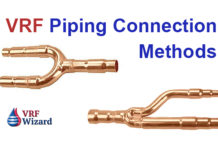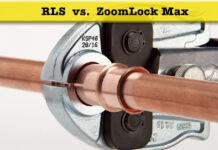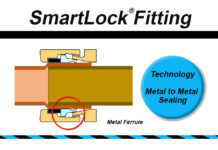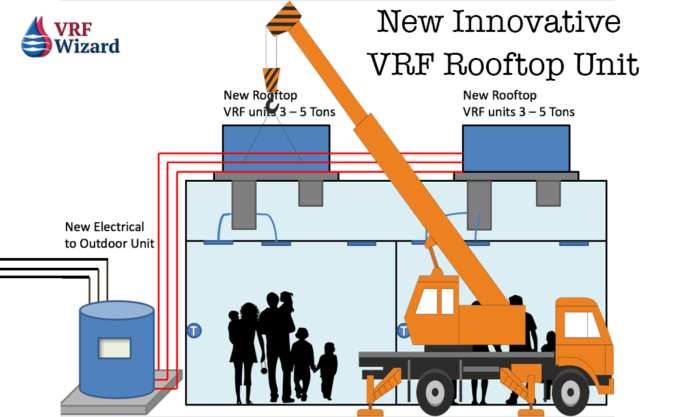Rooftop VRF Fan Coils
The latest in VRF innovation is coming this summer with the introduction of Carriers Rooftop VRF Fan Coils that will replace existing HVAC Rooftop Packaged Units. Instead of replacing the HVAC rooftop packaged unit with another newer model, you’ll now have the option of using that same roof curb to install a new Carrier Rooftop VRF Fan Coil.
VRF Replaces Rooftop Packaged Unit
For 3, 4 and 5 ton rooftop packaged units, whether vertical or horizontal discharge there will be an opportunity to switch existing rooftop units out with Carrier’s VRF Rooftop Fan Coils. The Carrier VRF Rooftop Fan Coils will not have a compressor or condenser coil & fan, so it will be much lighter. For those of you living under a strict seismic code or an upgraded structural code which made changing out an old packaged a structural upgrade nightmare, this will ease your pain.
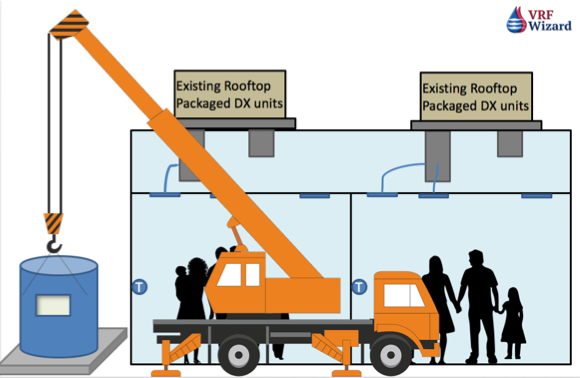
There is no need for adapter curbs as the new Toshiba Carrier VRF Rooftop unit sits on the same curb that the old Carrier Packaged DX units sat on. If the manufacture of the existing unit is different then the new Toshiba Carrier VRF Rooftop Fan Coils manufacture then an adapter curb would be required.
DSA & Structural Upgrades
One of the key benefits for contractors in California is that the Toshiba Carrier VRF Rooftop unit will be much lighter, helping you avoid any DSA (Department of State Architect) issues. The DSA reviews plans for public school construction and certain other state funded building projects to ensure that plans, specifications, and construction comply with California’s building codes (Title 24 of the California Code of Regulations).
To get around that review when replacing existing HVAC rooftop packaged units is to remain within a small percentage of the original unit’s weight. The concern when replacing like for like, packaged rooftop units is that the new units will weigh more and trigger a DSA review or structural upgrades due to the increase in the structural code since the units were first installed.
For those of you in other states or countries this factor may not apply, unless you have similar requirements. The new Toshiba Carrier VRF Rooftop Fan Coils weight much less than the existing HVAC Rooftop unit because it doesn’t contain the compressor, condenser or condenser fan.
If you have a building that has several 3 to 5-Ton rooftop packaged units, then you can use this new Toshiba Carrier VRF Rooftop unit to replace those Packaged DX units easily with a new VRF system. The Carrier VRF system is a 3-pipe system for VRF Heat Recovery and two-pipe for a heat pump system. The minimum outdoor tonnage is six tons.
VRF Components Housed in Rooftop Unit
All the components for the VRF system can be housed in the same box that the rooftop packaged unit manufacture is already using. The manufacture can just repurpose the packaged unit housing for the VRF components, which will leave plenty of room, as there is no need to house the compressor, condenser coil or condenser fan. When using a VRF Heat Recovery system the Branch Selector Box will be located within rooftop unit housing in some of that vacated space. The branch selector box will be a single port box dedicated to that unit.
Of course you will need to add new VRF outdoor units, refrigerant piping, electrical and some controls.
ASHRAE 15 & 34
One of the key benefits is that ASHRAE 15 & 34 to become a non-issue as there is no need to run the refrigerant piping within the space, unless you want to pick up some indoor fan coils.
Ventilation Air
The ASHRAE requirement to provide fresh outside air becomes a lot easier with this innovative VRF system as the Fan Coil portion of the system is outside where outside air is easily accessed. There is no need for a DOAS (dedicated outside air system) to feed these units, unless of course you have VRF fan coils that you would like to put on the inside of the building. Having the VRF fan coil replace old rooftop packaged DX systems eliminates the engineering challenge of providing a duct to each space or fan coil on the inside of the building.
VRF Manufactures Race to Compete in this new Market
Carrier has released their new innovative VRF Rooftop Unit which I’m sure will be followed by their competitions versions. As the market develops an appetite for these units the competitors will seek to join in on this innovation and grab a portion of the market for themselves. Start to identify opportunities for this new solution so that you are ahead of the competition.
Steps for Replacing Rooftop Package Units with VRF System
The following is brief outline of the steps you might take to replace the Rooftop Package Units. It does’t matter if the existing units were manufactured by units Trane, Lennox, Carrier, Day & Night, Daikin, etc.. The only difference in the beginning when the first manufacture enters the game the summer of 2018 is if that manufacture is replacing its own unit which would avoid the use of an adapter curb.
Step 1 – Design
Engineering review and design. Determine if the project makes financial sense for the owner, if so, secure engineering and documentation for jurisdictional approval. If the owner has decided to use the Design/Build method then this will shorten the schedule and make for a more collaborative approach.
Step 2 – Prepare for New VRF System
Before removing the existing HVAC Rooftop Package units, you will need to prepare the VRF system in advance so that there is minimum disruption of the HVAC system and occupants.
- Pour Concrete Pads for Outdoor VRF Units or Platforms on the Roof.
- Run new ACR Refrigerant Piping from Outdoor Units to the existing HVAC Packaged Units. Stub ACR Piping for future connection.
- Run new Electrical to the Outdoor VRF Units.
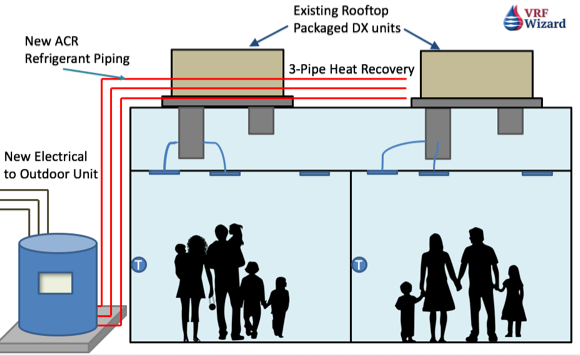
- Run control wire from Outdoor Units to existing Rooftop AC units for future connection.
- Install Main Controller if being used.
Step 3 – Remove Existing HVAC Rooftop Units
With most of the new VRF system installed, the last part will be the removal of the existing rooftop packaged HVAC units.
- Mobilize a crane to remove the existing rooftop HVAC units and install the new VRF Rooftop Fan Coils.
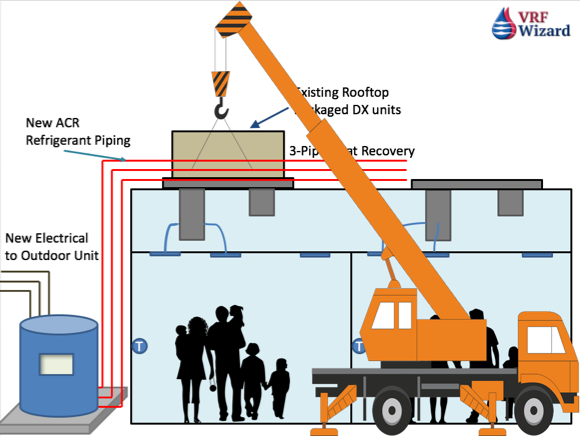
Step 4 – Install New VRF Rooftop Fan Coils
- Install the new Carrier VRF Rooftop Fan Coils onto the existing roof curbs or onto new adapter curbs if units are from a different manufacture.
- Connect ACR Refrigerant piping, control wiring & electrical. Charge with refrigerant, start and test.
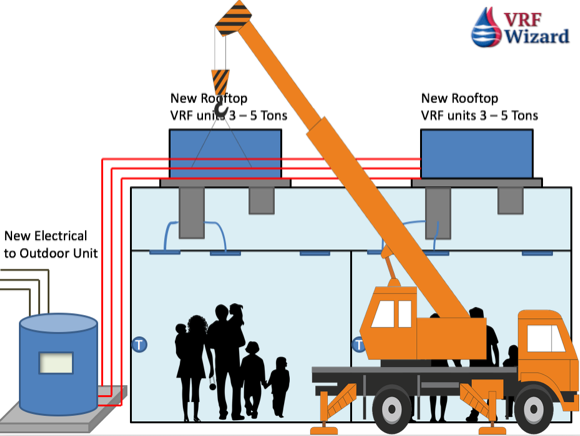
Summary of Advantages
- Lighter weight
- Avoids DSA review
- No structural upgrades
- Avoid ASHRAE 15 & #34 issues with refrigerant monitor and minimum space requirements.
- No DOAS or installation of outside air ducts. Direct access to OSA.
- Sits on existing manufactures curb or use an adapter curb with existing manufactures unit
- Increased efficiency
- No loud compressor above space below
- Some of the same options available on VRF Rooftop unit as a new Packaged DX unit. (Controls, Smoke Detector, etc …)
- Branch selector box installed in VRF Rooftop unit.
- Static pressures of 3/4” to 1” on efficient ECM fan motor
- More cost efficient over traditional VRF installations.
Disadvantages
- Need a new location for the Outdoor Air Units
- New electrical for Outdoor Units
- Installation of new refrigerant piping
- More expensive then a like for like replacement
Get Toshiba – Carriers Engineering Document for their 40QQ Variable Refrigerant Flow Rooftop System.





